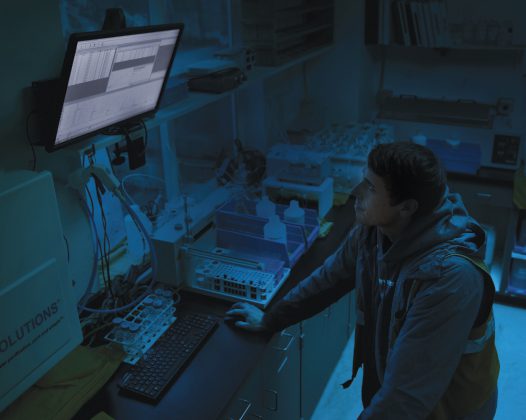There’s a few things in here I’m really excited about,” Brodie says as we step into the experimental section of the science labs. We’re on a walking tour of Aurora Innovations, the Oregon company that made its name with Roots Organics. Brodie, Aurora’s chief science officer, has dark dreadlocks, a buoyant step, and an easy manner of explaining complex scientific concepts. With enthusiasm, he holds up a glass jug full of viscous brown liquid and explains they have been experimenting with creating stable and sterile bokashi compost. Rows of identical jugs gleam on a metal rack. When he opens a container, it exudes a rich aroma—reminiscent of Belgian beer.
The company’s Eugene headquarters sprawls across 24-acres, encompassing two towering perlite furnaces, lush greenhouses, hangars full of organic soil and nutrients, and three labs. Aurora established the first lab in 2014. Prior to that, the company sent their samples to third party labs, but everyone was frustrated by the long turnaround time. In- house labs make it easier to quickly analyze every lot of raw material and each lot of finished product.
“We made the investment in our state-of the-art lab to collect nutritional data on plant tissue and soil so we can make the best products on the market,” says company co- founder Austin Weiner. “We’re committed to raising the bar for organic agriculture.”

One of the family-owned company’s many branches is devoted to rectifying the lack of solid data on the unique needs of cannabis across diverse cultivation styles. “We have a team of eight people who are able to devote every ounce of focus into improving our understanding of cannabis uptake and nutrition,” says co-founder Bowe McGinnis. This means studying the connection between plant tissue and soil. “We’re at a point where we can take a plant tissue sample, run it in our lab, compare it, and generate a report that makes suggestions of nutritional excesses and deficiencies to recommend exactly what that plant currently needs,” he adds.
Brodie elaborates: “Say you have a rock…or a bud. Using the ICP-OES, we could tell you what’s it’s composed of—what part per million of nearly every element on the periodic table.” This level of analysis allows Aurora to ensure consistent balance and potency in their soils and nutrients. To come full circle, they test plants grown in the soil to verify that the nutrient levels are consistent in both leaf and soil, which indicates optimum uptake of available nutrients.
The on-site greenhouses are lit gold by the sinking winter sun. In summer, they’re bustling with gardeners. Aurora grows plant starts to donate to local school gardening programs, as well as vegetables to support their free CSA for employees. But in November, the space is pleasantly still, quiet, and warm. “I’ve always been a plant guy,” Brodie says as we wander past tables of basil, lupines, marigolds, and tomatoes. “Yes, I’m very proficient in the lab—but I can also throw my Carhartts on and get dirty.”
Speaking of getting dirty, our next stop is a cavernous warehouse where two guys, one in a cowboy hat and one in a beanie, are sifting through samples, organizing bags of soil, tomato leaves, and roots for later testing in the lab.
“These guys are our wizards,” Brodie says.
Having an in-house lab also allows Aurora more creativity. The science teams can analyze biological material, like plant tissue and fungi, on their quest for beneficial microbes to boost plant health. In the microbiology lab, Brodie shows me slides of bacteria cultures he’s been growing. “We’re always looking for the next thing,” Brodie says, setting a slide in the transluminator, where the culture exudes bioluminescence. “That narrows down what it could be,” he says.

Recently, the labs have seen success on an ongoing priority project. “We’re confirming the genetic typing of the varieties of powdery mildew that attack cannabis and then working to isolate strategies to mitigate them,” McGinnis explains. “We’re doing that through trials, through collected tissue, through our internal DNA work, as well as looking for other organisms that can help fight it.”
McGinnis enjoys scouting for organisms that may be beneficial to plant health, and is evidently willing to risk life and limb to get them. “Have I told you the story about the crocodile?” he asks, and goes on to describe a trip to a Costa Rican mangrove swamp. “It was dusk. I was taking a sample from one of those mangrove crab holes. I’m kinda focused—half squatted down. Suddenly my friend starts yelling at me. I look immediately to my right. An arms-length away I see a crocodile’s nose start to come out of the water. And then the eyes. It was big. Its head was easily 16-inches wide and 30-inches long, just watching me with those eyes. It opens its mouth and hisses. As you can imagine, I finished the sample really quickly and we got the hell out of there.”
“You actually finished getting the sample?” I ask.
“Oh, hell yeah,” he says, laughing ruefully. “It’s actually sort of depressing because it’s really the story of an idiot who knew better who was nearly killed by a large reptile.”
Despite this self-deprecating remark, what the story really illustrates is a company that takes a hands-on approach to learning what the natural world can teach us. When I ask Brodie what makes Aurora different from other soil companies, he responds with heartfelt enthusiasm “There’s a nice balance here,” he says. “We’re always seeking the knowledge of the past, but using the tools of today. I think it’s important to use our collective knowledge in a way that makes sense for us and the other organisms on this planet. That’s what we’re doing here.”

